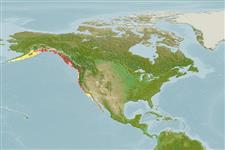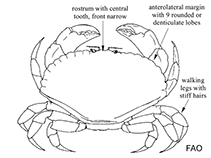Advertisement
Cancer productus Randall, 1840
Red rock crab| Native range | All suitable habitat | Point map | Year 2050 |

|
| This map was computer-generated and has not yet been reviewed. |
| Cancer productus AquaMaps Data sources: GBIF OBIS |
Upload your photos
Google image | No image available for this species;
drawing shows typical species in Cancridae.
Google image | No image available for this species;
drawing shows typical species in Cancridae.
United States (contiguous states) country information
Common names:
[No common name]
Occurrence: native
Salinity: marine
Abundance: | Ref:
Importance: | Ref:
Aquaculture: never/rarely | Ref:
Regulations: no regulations | Ref:
Uses: no uses
Comments: C: Refs. 78177, 78494, 93916, 865, 78677; R: Ref. 78177.
National Checklist:
Country Information: https://www.cia.gov/library/publications/resources/the-world-factbook/geos/us.html
National Fisheries Authority: http://www.nmfs.gov
Occurrences: Occurrences Point map
Main Ref: Jensen, G.C., 1995
National Database:
Occurrence: native
Salinity: marine
Abundance: | Ref:
Importance: | Ref:
Aquaculture: never/rarely | Ref:
Regulations: no regulations | Ref:
Uses: no uses
Comments: C: Refs. 78177, 78494, 93916, 865, 78677; R: Ref. 78177.
National Checklist:
Country Information: https://www.cia.gov/library/publications/resources/the-world-factbook/geos/us.html
National Fisheries Authority: http://www.nmfs.gov
Occurrences: Occurrences Point map
Main Ref: Jensen, G.C., 1995
National Database:
Common names from other countries
Classification / Names Tên thường gặp | Các synonym ( Các tên trùng) | Catalog of Fishes (gen., sp.) | ITIS | CoL | WoRMS
Environment: milieu / climate zone / depth range / distribution range Sinh thái học
; Mức độ sâu 0 - 90 m (Tài liệu tham khảo 78177). Subtropical, preferred 9°C (Tài liệu tham khảo 107945); 61°N - 30°N, 168°W - 116°W (Tài liệu tham khảo 78486)
Distribution Các nước | Các khu vực của FAO | Các hệ sinh thái | Những lần xuất hiện | Những chỉ dẫn
Eastern Pacific: Nunivak and Kodiak Islands, Alaska to Isla San Martin, Baja California. Subtropical to temperate.
Length at first maturity / Bộ gần gũi / Weight / Age
Maturity: Lm ? range ? - ? cm Max length : 20.0 cm CW con đực/không giới tính; (Tài liệu tham khảo 78486)
Depth range is from intertidal to about 90 m. Max size from male specimen captured off Punta Banda, Baja California (Ref. 78177). Forages on shores protected from wave action. Juveniles and mating pairs occur in the intertidal zone only on nocturnal high tides (Ref. 78483). Buries itself in the substrate during periods of inactivity (Ref. 78491). Excavating predator (Ref. 78493).
Life cycle and mating behavior Chín muồi sinh dục | Sự tái sinh sản | Đẻ trứng | Eggs | Sự sinh sản | Larvae
Most species produce a single brood each winter but may reach up to two or three broods per year and the reproductive life span is about 4 years. The cumulative number of broods produced over the maximum life span is about 4 broods.
Main reference
Các tài liệu tham khảo | Người điều phối | Người cộng tác
Jensen, G.C. 1995. (Tài liệu tham khảo 78177)
IUCN Red List Status
(Tài liệu tham khảo 130435: Version 2024-2)
CITES status (Tài liệu tham khảo 108899)
Not Evaluated
CMS (Tài liệu tham khảo 116361)
Not Evaluated
Human uses
Các nghề cá: Tính thương mại
FAO - Các nghề cá: landings | FishSource | Biển chung quanh ta
Các công cụ
Thêm thông tin
Các nước
Các khu vực của FAO
Các hệ sinh thái
Những lần xuất hiện
Những chỉ dẫn
Stocks
Sinh thái học
Thành phần thức ăn
Các loại thức ăn
Các khu vực của FAO
Các hệ sinh thái
Những lần xuất hiện
Những chỉ dẫn
Stocks
Sinh thái học
Thành phần thức ăn
Các loại thức ăn
Tên thường gặp
Các synonym ( Các tên trùng)
Các động vật ăn mồi
Sự tái sinh sản
Chín muồi sinh dục
Đẻ trứng
Sự sinh sản
Eggs
Egg development
Các synonym ( Các tên trùng)
Các động vật ăn mồi
Sự tái sinh sản
Chín muồi sinh dục
Đẻ trứng
Sự sinh sản
Eggs
Egg development
Các nguồn internet
BHL | BOLD Systems | CISTI | DiscoverLife | FAO(Các nghề cá: ; publication : search) | GenBank (genome, nucleotide) | GloBI | Gomexsi | Google Books | Google Scholar | Google | PubMed | Cây Đời sống | Wikipedia (Go, tìm) | Tạp chí Zoological Record
Estimates based on models
Preferred temperature
(Ref. 115969): 8 - 12.1, mean 9.6 (based on 82 cells).




